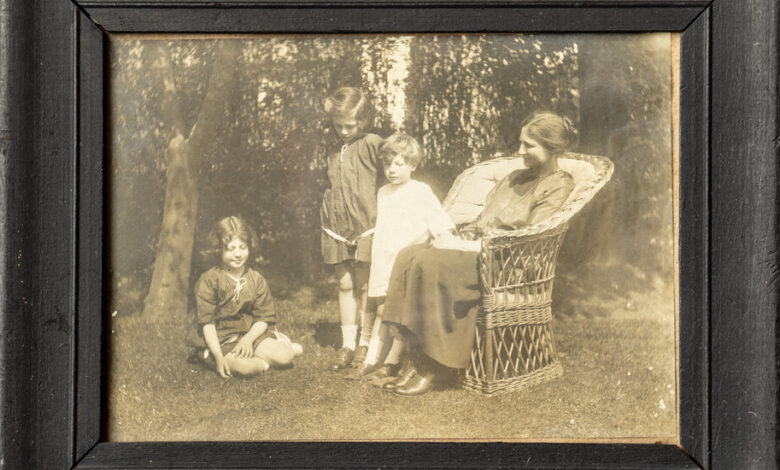The Secret of Thomas Mann’s Translator

Before she could sign on to translate the entirety of Thomas Mann, the giant of German letters, into English, Helen Tracy Lowe-Porter had to translate herself.
An American married to a rising paleography scholar at Oxford, Lowe-Porter was raising three daughters and helping make ends meet with occasional translation work when, in 1922, Alfred A. Knopf sent “Buddenbrooks,” Mann’s first novel, her way.
Lowe-Porter judged the chances of a warm reception for a woman translator to be slim, and became H.T. Lowe-Porter on the title pages of the two-volume Knopf edition, for which she was paid $750. She would go by that name on Mann’s works from then on, including, in 1927, “The Magic Mountain.” By 1929, Mann had been awarded the Nobel Prize.
Mann’s preference, too, had been for a male translator for “The Magic Mountain.” He wrote to Lowe-Porter, “the new book, with its deeply intellectual and symbolic character, makes quite other demands on the translator — demands which I sometimes deem would be more readily met by a male rather than a female temperament.” Only after Hermann Georg Scheffauer, his translator of choice, died suddenly, did they continue to work together.
For many, Lowe-Porter’s New York Times obituary in 1963 would be the first indication that she wasn’t a man.
Yet as chronicled by Jo Salas in her new novel, “Mrs. Lowe-Porter,” out Feb. 1 from Jackleg Press, Lowe-Porter had her own aspirations as a poet, short story writer and novelist. Her play “Abdication,” a thinly-veiled portrait of Edward VIII’s dethroning, was staged by the Gate Theatre company in Dublin and published by Knopf.
Even as her translations helped to stem the tide of anti-German sentiment directed at Mann and German culture after World War I, her efforts were stymied by the breakneck pace of Knopf’s contractual commitment to release at least one Mann translation per year. The arrangement covered 22 books, until Lowe-Porter informed Mann in 1951 that she wanted time for herself.
In “Mrs. Lowe-Porter,” she orders a reluctant housekeeper to empty a bookshelf holding the complete set.
Lowe-Porter “struggled all her life with questions of what it meant to be a woman, to be independent, to be an artist,” Salas said over lunch at the Café Sabarsky in the Neue Galerie, the museum for German and Austrian art in New York. She fought self-doubt and depression, and the issue of her gender has remained an undercurrent in debates about the value of her translations. (Of his experience reading “Abdication,” the theater critic George Jean Nathan wrote to Knopf, “All women authors over 65 should be turned over to the Ku Klux Klan.”)
Such lines hit a familiar nerve for Salas. Born in New Zealand, by 12 she had developed a passion for social justice, she said, “and joined the campaign against nuclear disarmament.” She met her husband, Jonathan Fox, an American-born grandson of Lowe-Porter’s, when he was a Fulbright scholar there, and they married after he finished a stint in the Peace Corps during the Vietnam War.
Together they founded Playback Theater, now based in New Paltz, N.Y. Salas has written several books on the interactive theater form, and a novel, “Dancing with Diana,” about a little-known incident involving Diana, Princess of Wales.
Salas said she was intrigued by Fox’s stories about Lowe-Porter from the start, and heard more from her mother-in-law, Lowe-Porter’s daughter Patricia Tracy Lowe, over the years.
An avowed feminist whose earliest role model was her bluestocking aunt Charlotte Endymion Porter, an editor of the magazine “Poet Lore,” Lowe-Porter was known to greet young grandchildren with startling recitations from “Macbeth,” one of her granddaughters, the writer Anneke Campbell, said. She set a left-leaning tone for successive generations: It’s unlikely she would have been sympathetic to the politics of her great-grandson Boris Johnson, Salas said.
A significant amount of the research material for Salas’s novel came from Tracy Lowe, who amassed files of letters, newspaper clippings, old photographs and other records for a dual biography of her parents, which she left in rough draft when she died.
“She was a real daddy’s girl,” Salas said of Tracy Lowe. Salas felt the unfinished biography unfairly favored Lowe-Porter’s husband, Elias Lowe, whose vaguely Freudian justifications for extramarital affairs his wife accepted, as Salas learned from Tracy Lowe, until he confessed to a relationship with one of their eldest daughter’s friends. Packing her Gladstone bag, Lowe-Porter went to live elsewhere. It took Lowe two years to convince her to follow him after he joined the fledgling Institute for Advanced Study in Princeton in 1934. She stepped in as a translator for Albert Einstein there, and made a lasting friend.
Compared with Elias Lowe’s archive at the Morgan Library in New York, Lowe-Porter’s paper trail was less substantial, Salas said, which contributed to her decision to tell Lowe-Porter’s story through fiction.
She interviewed family members and consulted “In Another Language,” a book by John C. Thirlwall about the long relationship between Mann and Lowe-Porter which includes two of her essays on translation. Though Lowe-Porter, in self-deprecating fashion, referred to translation as “this little art,” she treated it as anything but. She started not just with a dictionary, but “a whole reference shelf,” she told an interviewer (and, for “Doctor Faustus,” a gramophone for playing Beethoven’s Piano Sonata No. 32, Opus 111 on repeat).
She described days spent agonizing over her ability to do justice to Mann’s complex, nuanced prose, then, as she put it in her preface to “Buddenbrooks,” “transferring the spirit first and the letter so far as it might be.” (She made her share of mistakes, documented in detail by later scholarship.) In keeping with translation practice of the period, she wanted Mann’s German to disappear inside her English.
“There’s always been the idea that every generation needs its own translations,” said Ann Goldstein, a translator best known for working on novels by Elena Ferrante. “The originals don’t date, the translations do. I looked at a couple of Lowe-Porter translations again recently, and now they seem stiff to me.”
Another challenge for Lowe-Porter was Mann’s tendency to send her his manuscripts piecemeal, only to require re-translation after his revisions. More modifications, to the point of pruning entire passages, might happen during the editorial process at Knopf, which placed a premium on publishing a Mann agreeable to an American readership, some of it still puritanically skittish about what it considered the loosening of moral standards by modern literature.
Lowe-Porter had few qualms about the sexual content and subtext in Mann’s work, Salas said. Still, rather than taking traditional publishing conventions and reigning decency codes to task for obscuring the erotic themes in Mann’s work, many of Lowe-Porter’s critics have blamed her, casting her as a bowdlerizing prude.
The writer Colm Toibin, who in 2021 published “The Magician,” a novel dealing with Mann’s homosexuality, said that such false assumptions “had quite a lot to do with her being a woman.”
The time pressures on Lowe-Porter to produce only mounted over the years. “I don’t know how she did it,” said Susan Bernofsky, a professor of creative writing and the director of the literary translation program at Columbia University.
Bernofsky is currently working on a new translation of “The Magic Mountain,” and said that two years into the project, she is only halfway through. “Do I have a bone to pick with this and that in Lowe-Porter? Yes,” she said, “but I think she did a phenomenal job.”
Exiled from Hitler’s Germany, Mann and his wife, Katia, also settled in Princeton in 1938. There they moved in the same rarefied intellectual and social circles as the Lowes, said Stanley Corngold, an emeritus professor of German and comparative literature at Princeton and the author of “The Mind in Exile: Thomas Mann in Princeton.”
In 1941 the Manns relocated to Los Angeles, until the McCarthy era forced them back to Europe. Mann died in Zurich in 1955.
Not until 1995 did Knopf inaugurate new translations of Mann’s work, by John E. Woods, heralded as an improvement on Lowe-Porter’s work for departing from what the New Yorker writer Alex Ross has called Lowe-Porter’s “woebegone old versions.”
Nonetheless, said Peter Constantine, the director of the literary translation program at the University of Connecticut, who in 1997 translated a group of stories by Mann for publication as “Six Early Stories,” “the word-for-word comparisons by translators who came later can seem kind of nit-picking.”
In 2017, both camps were in evidence when the translator Kate Briggs published a meditation on her craft, titled “This Little Art” in honor of Lowe-Porter, which the translator Benjamin Moser decried as wrongheaded and disingenuous in The New York Times Book Review.
For Salas, “Mrs. Lowe-Porter” remained its own act of translation. In a letter to Time magazine in 1944, Mann was on his most decorous behavior as he expressed “the good fortune of finding a translator of the devotion and linguistic talent of Mrs. Helen Lowe-Porter.”
Salas wanted her novel to leave the two under warmer circumstances.
“Without Mrs. Lowe,” says Mann as he toasts his translator at one of their last dinner parties together in Princeton, “I am an unknown German only. To Helen Lowe-Porter!”





